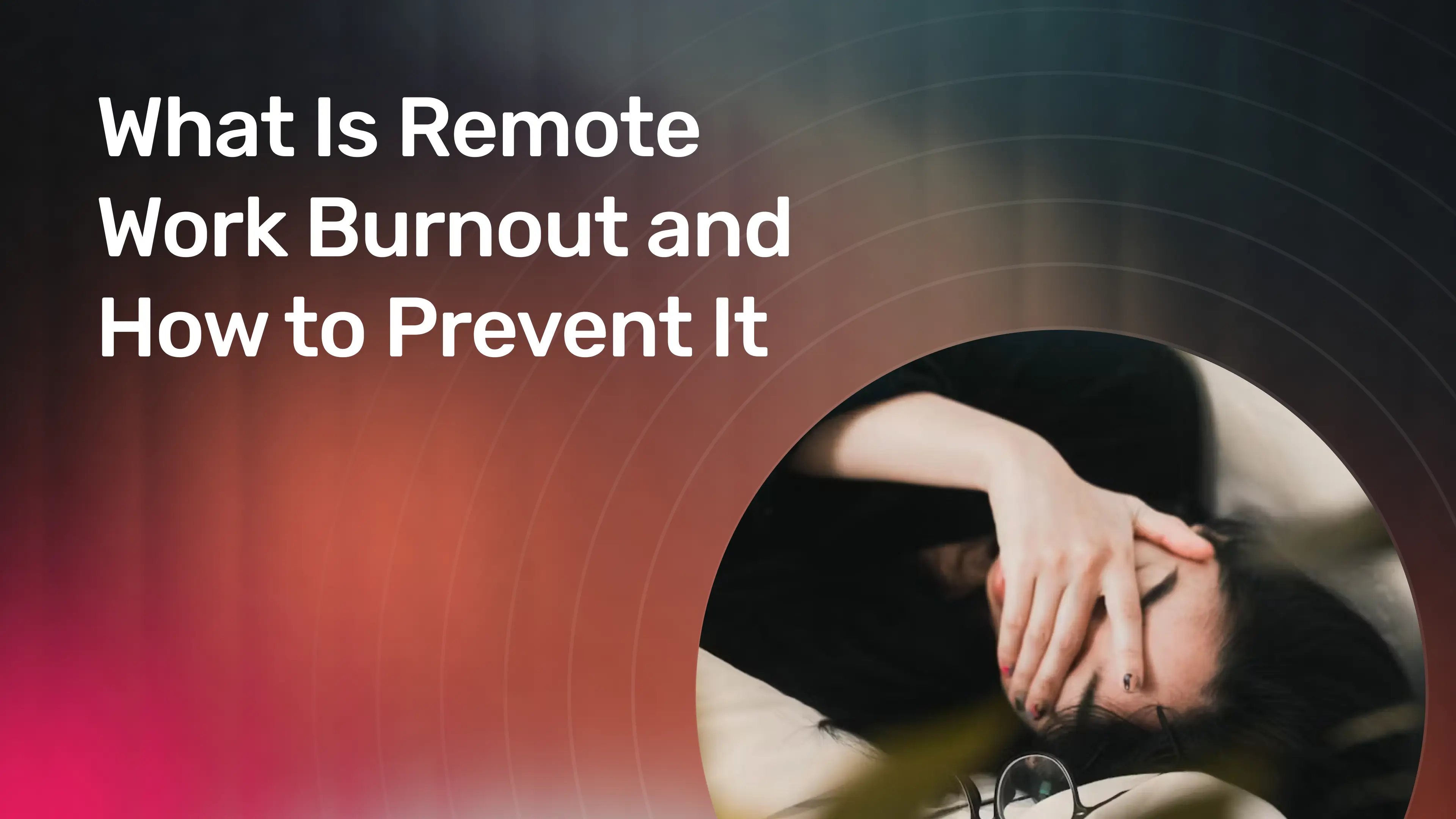What Is Remote Work Burnout and How to Prevent It
As we all know, remote working is all about the flexibility and freedom to choose how you want to work. From picking the ideal location to get productive to scheduling your own working hours and breaks - it's all about achieving the perfect balance.
However, without the structuring of traditional office setups, it can be easy to overwork, skip breaks, or feel like you're always on. And before you know it, the freedom you once loved can become overwhelming.
Sounds common? Worry not, as in this guide, we're exploring how to prevent remote work burnout, improve your work-life balance, and achieve the perfect remote lifestyle, no matter where and how you choose to work.

What causes remote work burnout?
Burnout can sneak up on everyone, even when working from the comfort of your home, a cosy coffee spot, or your favourite world destination. Let's explore some of the most common causes behind remote working burnouts and how they might be affecting you.
Disconnect issues
When working remotely, it's very easy to feel disconnected from your fellow team members or your company culture. Without daily in-person interactions, it's common for remote workers to miss spontaneous conversations and quick problem-solving that might happen in an office. Over time, this sense of being out of the loop can make you feel less engaged and potentially lead to burnout.
Communication issues
We all know that remote work relies on virtual communication, and it's not surprising that some things can get lost in translation. Misunderstandings, delayed responses, and unclear work instructions can create unnecessary stress. Plus, the constant flow of messages, emails, and meetings can leave you overwhelmed and mentally drained.
Isolation
While remote work offers all the work freedom in the world, it can also be lonely. Spending long hours working alone without face-to-face interactions with your coworkers can make you feel isolated and lead to feelings of burnout, even if you enjoy your independence.
Lack of boundaries
Without a physical office to leave behind, it can be challenging to draw the line between work and personal life. If you're working remotely, you've surely found yourself checking emails late at night or skipping breaks during the day. Over time, this type of blurring of boundaries can indeed lead to overworking, exhaustion, and burnout.
Poor workspace setup
Not having an ergonomic or comfortable workspace can make remote working both physically and mentally taxing. Distractions at home, noisy environments, and constant interruptions can be actual killers for your focus and energy levels, leaving you feeling ultimately burned out.
Lack of routine
If you're working without a structured routine and the typical office hours, days can easily blur together and make it harder to manage your time. Lack of structuring often results in working odd hours, neglecting self-care, and feeling in a constant state of alert, all of which can contribute to burnout.

Common symptoms of remote work burnout
Remote working burnout can show up in many ways, and it's important to recognise the signs before they become too overwhelming. Below, we're exploring some of the most common symptoms to watch out for.
Constant fatigue
One of the most significant signs of burnout is feeling tired all the time, even after a whole night's sleep. Remote workers often struggle with constant exhaustion because they push themselves too hard, skip breaks, or simply can't fully unwind when the workday ends.
Excessive stress
Stress levels can rise quickly when you're always "on the clock" or simply juggling multiple tasks at the same time. If you're feeling overwhelmed, anxious, or like you're constantly in "crisis mode", it could be a sign that burnout is creeping in.
Insomnia and trouble sleeping
Burnout often disrupts regular sleep patterns. If you find yourself tossing and turning at night, unable to fall asleep, or waking up frequently, you might be racing with work-related worries, even when you're trying to relax.
Loss of motivation
Feeling unmotivated or uninterested in the tasks you were once excited about can be a big red flag. When you're burned out, even the thought of starting a new project or completing a routine task might feel like too much.
Poor performance
If you notice that your work quality is starting to slip or you're making more mistakes than usual, burnout can be the reason. When your brain is overloaded, it's hard to stay focused, think clearly, and stay productive in your normal work activities.
Emotional exhaustion
Another common symptom of work burnout is feeling emotionally drained, irritable, and disconnected from your feelings. This can lead to struggling to manage your emotions and impact your relationships at work and home.
Physical symptoms
Burnouts don't just affect you mentally - they can manifest physically, too. Headaches, muscle tension, digestive problems, and even frequent illness are very common symptoms of long-term stress and work burnout.

How does remote work burnout impact businesses?
Burnouts don't just affect the well-being of remote employees, but they can also have serious consequences for the business as a whole. Experiencing burnout feelings is not a good sign for the company, as it harms the team productivity and the overall business growth. Let's explore some of the most common impacts.
Loss of profit
When remote employees start feeling burnt out, their productivity also suffers, leading to delays, mistakes, and potentially missed opportunities. The loss of work efficiency in your employees can ultimately affect the company's bottom line and lead to less profits and less growth.
Increased staff turnover
Burned-out employees are more likely to quit their jobs, either to escape the stress of work or to find a healthier work environment. High turnover rates not only disrupt the team's workflow but also lead to additional costs for hiring and training new team members.
Decreased quality of work
Remote work burnout is one of the main reasons for a drop in the quality of work being produced. When employees are exhausted or unmotivated, their attention to detail suffers, which always leads to errors, missed deadlines, and lower creativity.
Decreased employee engagement
When burnout sets in, many remote employees are most likely to become disengaged. This means stopping to participate in meetings, contributing ideas, or even taking care of the company's mission. This type of disengagement can affect team morale and the overall remote working culture of the organisation.
Strained relationships with clients
Burned-out employees commonly struggle to maintain positive relationships with clients and customers. The lack of energy and enthusiasm can affect communication and the quality of service, which can damage the company's reputation and client retention.
Increased absenteeism
Employees who experience burnout are more likely to take sick leave or time off more often to cope with their stress. This can disrupt the company's regular workflow, put extra pressure on the rest of the team members, and ultimately damage the overall team performance.

How to prevent remote work burnout?
If you are experiencing remote working burnout, worry not, as it can be avoided with the right strategies and habits in place. By taking a few proactive steps, you can create a healthier work-life balance and maintain your well-being while still being productive at work. Here are a few effective ways to prevent and avoid remote work burnout.
Time blocking
The first habit to help you establish a routine and create boundaries is setting specific times for work tasks, breaks, and personal activities. This will allow you to focus on one task at a time and make it easier for you to stay productive without feeling overwhelmed.
Task prioritisation
When working remotely, it's important to remember that not every task is equally urgent or important. Hence, it can be helpful to use to-do lists, productivity apps, or different tools to focus on high-priority tasks first, which will help you reduce your stress and avoid feeling stretched thin.
Prioritise exercise and self-care
One of the most effective ways to prevent work burnout is regular exercise and self-care activities like meditation. Making time for your health is essential to reduce stress, recharge your energy, and avoid burnout, even on your busiest work days.
Take regular holidays
Taking time off for your private life activities is essential, even when you have the freedom to work remotely. A proper break will allow you to reset and come back to work feeling refreshed, re-energised, and ready for new work challenges. Hence, plan regular holidays to give yourself a well-deserved break.
Create a dedicated workspace
Having a designated workspace will help you separate your work from your personal life. When you physically leave your workspace at the end of the day, it will signal your brain that the workday is over and it's time to switch off from work mode.
Foster open communication
Finally, it's of great importance to encourage honest conversations with your manager or team about your workload and expectations. Open communication will ensure that you get the support you need to stay productive and help you prevent feeling overwhelmed with work activities.

How can companies help reduce burnout?
Preventing remote working burnout isn't just an individual responsibility. In fact, the company plays a huge role in creating a supportive and productive environment for the employees.
By taking a couple of simple steps, businesses can help reduce burnout and increase productivity and satisfaction among team members. Here are some ways to do that:
Recognise signs of burnout
Managers and organisation inspiring leaders should be well-versed in identifying signs of burnout, such as decreased productivity, disengagement, and emotional exhaustion. By identifying these issues early, companies can prevent them from escalating and maintain productivity among team members.
Have open communication
Nurturing a company culture of open communication allows employees to express their concerns without fear of judgment. Managers should organise regular check-ins and one-on-one meetings to understand team members' workload pressures and provide the necessary support.
Offer async and flexible work agreements
Giving employees the freedom to work at their own pace and schedule is one of the best ways to alleviate work stress. Asynchronous communication and flexible working hours will help team members balance work with their personal lives and significantly reduce the risk of burnout.
Schedule company self-care days
Organisations should set aside dedicated days where the whole company takes a break. Whether it's allowing a longer weekend or having days with no calls and meetings, self-care days will help your team members re-energise, recharge, and get ready to face work challenges again.
Provide mental health resources
Offering access to mental health resources, such as counselling services or wellness programmes, demonstrates a commitment to employee well-being. Ensure that your employees have access to such resources and encourage them to use them when needed to avoid feelings of burnout.
Encourage taking breaks
Last but not least, it's important to promote a culture where breaks are seen as essential, not optional. Taking lunch breaks and short screen pauses can improve focus and help prevent feelings of burnout.
To sum up
Remote work offers the ultimate flexibility and freedom but also comes with challenges that can lead to burnout if not addressed. By recognising the signs and taking proactive steps, you can create a healthier and more productive work environment.
However, prioritising well-being is essential not just for employees but also for long-term business success. Remember, a happy and healthy team is always the most productive one.
